Beyond Proximity: Assessing Social Equity in Park Accessibility for Older Adults Using an Improved Gaussian 2SFCA Method
Abstract
1. Introduction
2. Research Area and Data
2.1. Research Area
2.2. Research Data
3. Research Methods
3.1. Park Quality Fairness Evaluation System
3.2. Accessibility Analysis Based on the Improved Gaussian Two-Step Floating Catchment Area Method (2SFCA)
3.3. Social Equity Evaluation Method
4. Results
4.1. Comprehensive Evaluation of the Quality of Parks in Gulou District
4.2. Evaluation of Accessibility of UPGS for Older Adults Under Different Transportation Modes
4.3. Analysis of the Social Equity of UPGS Accessibility for Older Adults in Gulou District
- (1)
- Imbalanced UPGS spatial distribution: A significant disparity is found between the clustered and excessive UPGS availability in some districts and severe deficits in areas with higher older population densities, indicating substantial inequality in access to nearby green spaces.
- (2)
- Unreasonable spatial configuration of UPGS quality: UPGSs of differing quality levels are distributed sporadically throughout the study area, regardless of the actual distribution of older adults or their particular activity demands. A significant disparity exists between high-quality, well-equipped parks and ordinary green spaces with outdated facilities and limited functions, leading to compromised service efficacy for the older adults. Consequently, the inferior quality and insufficient integration of age-friendly facilities in these spaces restrict their usability, fostering inequitable access to premium green resources despite geographical closeness.
- (3)
- Mismatch between UPGS supply and age-specific demands: Current planning does not adequately align with the activity preferences of older adults, creating a disconnect between supply and demand. As a result, UPGSs that are physically present often fail to effectively serve older adults living nearby. This mismatch highlights an inequity in meeting the specific environmental needs of this population.
5. Discussion
6. Conclusions
Author Contributions
Funding
Data Availability Statement
Acknowledgments
Conflicts of Interest
Appendix A
| Questionnaire on Park Usage Among Older Adults |
| I. Demographic Information |
| 1. Gender: |
| A. Male (52%) |
| B. Female (48%) |
| 2. Age group: |
| A. 50–60 years (23%) |
| B. 60–70 years (45%) |
| C. 70–80 years (27%) |
| D. ≥80 years (5%) |
| 3. Residential community: ______ |
| 4. Most frequently visited park: ______ |
| II. Park Usage Patterns |
| 5. Preferred park visitation times (multiple selections allowed): |
| A. Early morning (5:00–9:00) (68%) |
| B. Morning (9:00–12:00) (28%) |
| C. Afternoon (12:00–17:00) (35%) |
| D. Evening (after 17:00) (52%) |
| 6. Primary transportation mode to parks: |
| A. Walking (73%) |
| B. Public transit (25%) |
| C. Other: ______ (2%) |
| 7. Typical travel time to parks: |
| A. ≤15 min (41%) |
| B. 15–30 min (46%) |
| C. >30 min (13%) |
| III. Park Environment and Facility Evaluation |
| 8. Satisfaction with basic environment (e.g., space, cleanliness): |
| A. Satisfied (38%) |
| B. Neutral (45%) |
| C. Dissatisfied (17%) |
| 9. Does neighborhood park greenery meet daily leisure needs? |
| A. Fully meets (22%) |
| B. Partially meets (53%) |
| C. Inadequately meets (25%) |
| 10. Completeness of park facilities: |
| A. Complete (29%) |
| B. Moderate (47%) |
| C. Incomplete (24%) |
| 11. Satisfaction with service quality (e.g., staff attitude, activity diversity): |
| A. Satisfied (32%) |
| B. Neutral (51%) |
| C. Dissatisfied (17%) |
| 12. Satisfaction with ecological environment (e.g., green coverage, water cleanliness): |
| A. Satisfied (35%) |
| B. Neutral (50%) |
| C. Dissatisfied (15%) |
| 13. Perceived overall park safety: |
| A. Safe (86%) |
| B. Neutral (13%) |
| C. Unsafe (1%) |
| 14. Overall park satisfaction: |
| A. Satisfied (51%) |
| B. Neutral (41%) |
| C. Dissatisfied (8%) |
| IV. Additional Suggestions |
| 15. Further recommendations for park environments, facilities, or services: |
| ______ |
| We sincerely appreciate your participation! |
References
- Akpinar, A. How Is Quality of Urban Green Spaces Associated with Physical Activity and Health? Urban For. Urban Green. 2016, 16, 76–83. [Google Scholar] [CrossRef]
- Cao, Y.; Guo, Y.; Fang, Y.; He, X. Refuge Green Space Equity: A Case Study of Third Ring Road on Chengdu. Land 2023, 12, 1460. [Google Scholar] [CrossRef]
- Li, X.; Ma, X.; Hu, Z.; Li, S. Investigation of Urban Green Space Equity at the City Level and Relevant Strategies for Improving the Provisioning in China. Land Use Policy 2021, 101, 105144. [Google Scholar] [CrossRef]
- Meng, D.; Zhang, J.; Cai, Z.; Xu, S. Evaluating the Accessibility of Seniors to Urban Park Green Spaces. J. Urban Plan. Dev. 2024, 150, 05024021. [Google Scholar] [CrossRef]
- Gong, F.; Zheng, Z.-C.; Ng, E. Modeling Elderly Accessibility to Urban Green Space in High Density Cities: A Case Study of Hong Kong. Procedia Environ. Sci. 2016, 36, 90–97. [Google Scholar] [CrossRef]
- Zhang, F.; Li, D.; Ahrentzen, S.; Zhang, J. Assessing Spatial Disparities of Accessibility to Community-Based Service Resources for Chinese Older Adults Based on Travel Behavior: A City-Wide Study of Nanjing, China. Habitat Int. 2019, 88, 101984. [Google Scholar] [CrossRef]
- Xu, Y.; Zhou, C.; Hu, B. Measuring the Accessibility of Emergency Shelters Based on an Improved Two-Step Floating Catchment Area Model. Int. J. Digit. Earth 2025, 18, 2479864. [Google Scholar] [CrossRef]
- Li, P.; Wu, W.; Yin, Y. Enhanced Accessibility to Park Cooling Services in Developed Areas: Experimental Insights on the Walkability in Large Urban Agglomerations. Build. Environ. 2025, 272, 112665. [Google Scholar] [CrossRef]
- Zhang, D.; Ma, S.; Fan, J.; Xie, D.; Jiang, H.; Wang, G. Assessing Spatial Equity in Urban Park Accessibility: An Improve Two-Step Catchment Area Method from the Perspective of 15-Mintue City Concept. Sustain. Cities Soc. 2023, 98, 104824. [Google Scholar] [CrossRef]
- Tannous, H.O.; Major, M.D.; Furlan, R. Accessibility of Green Spaces in a Metropolitan Network Using Space Syntax to Objectively Evaluate the Spatial Locations of Parks and Promenades in Doha, State of Qatar. Urban For. Urban Green. 2021, 58, 126892. [Google Scholar] [CrossRef]
- Hansen, W.G. How Accessibility Shapes Land Use. J. Am. Inst. Plan. 1959, 25, 73–76. [Google Scholar] [CrossRef]
- Wu, L.; Kim, S.K.; Lin, C. Socioeconomic Groups and Their Green Spaces Availability in Urban Areas of China: A Distributional Justice Perspective. Environ. Sci. Policy 2022, 131, 26–35. [Google Scholar] [CrossRef]
- Wang, S.; Wang, M.; Liu, Y. Access to Urban Parks: Comparing Spatial Accessibility Measures Using Three GIS-Based Approaches. Comput. Environ. Urban Syst. 2021, 90, 101713. [Google Scholar] [CrossRef]
- Li, C.; Wang, J. Using an Age-Grouped Gaussian-Based Two-Step Floating Catchment Area Method (AG2SFCA) to Measure Walking Accessibility to Urban Parks: With an Explicit Focus on Elderly. J. Transp. Geogr. 2024, 114, 103772. [Google Scholar] [CrossRef]
- Chen, P.; Wang, W.; Qian, C.; Cao, M.; Yang, T. Gravity-Based Models for Evaluating Urban Park Accessibility: Why Does Localized Selection of Attractiveness Factors and Travel Modes Matter? Environ. Plan. B Urban Anal. City Sci. 2024, 51, 904–922. [Google Scholar] [CrossRef]
- Wu, W.; Zheng, T. Establishing a “Dynamic Two-Step Floating Catchment Area Method” to Assess the Accessibility of Urban Green Space in Shenyang Based on Dynamic Population Data and Multiple Modes of Transportation. Urban For. Urban Green. 2023, 82, 127893. [Google Scholar] [CrossRef]
- Łaszkiewicz, E.; Wolff, M.; Andersson, E.; Kronenberg, J.; Barton, D.N.; Haase, D.; Langemeyer, J.; Baró, F.; McPhearson, T. Greenery in Urban Morphology: A Comparative Analysis of Differences in Urban Green Space Accessibility for Various Urban Structures across European Cities. Ecol. Soc. 2022, 27, 22. [Google Scholar] [CrossRef]
- Li, X.; Huang, Y.; Ma, X. Evaluation of the Accessible Urban Public Green Space at the Community-Scale with the Consideration of Temporal Accessibility and Quality. Ecol. Indic. 2021, 131, 108231. [Google Scholar] [CrossRef]
- He, B.; Hu, J.; Liu, K.; Xue, J.; Ning, L.; Fan, J. Exploring Park Visit Variability Using Cell Phone Data in Shenzhen, China. Remote Sens. 2022, 14, 499. [Google Scholar] [CrossRef]
- Lin, Y.; Zhou, Y.; Lin, M.; Wu, S.; Li, B. Exploring the Disparities in Park Accessibility through Mobile Phone Data: Evidence from Fuzhou of China. J. Environ. Manag. 2021, 281, 111849. [Google Scholar] [CrossRef]
- Benati, G.; Calcagni, F.; Matellozzo, F.; Ghermandi, A.; Langemeyer, J. Unequal Access to Cultural Ecosystem Services of Green Spaces within the City of Rome—A Spatial Social Media-Based Analysis. Ecosyst. Serv. 2024, 66, 101594. [Google Scholar] [CrossRef]
- Jin, Y.; Xu, Y.; Liu, W. The Green Quality of Urban Spatial Development: A Multi-Dimensional and Multi-Regional Model Using Big Data. Urban For. Urban Green. 2023, 85, 127953. [Google Scholar] [CrossRef]
- Kaufmann, T.; Vispute, S.; Kansal, M.; O’Brien, D.T.; Shekel, T.; Gabrilovich, E.; Wellenius, G.A.; Dijkstra, L.; Veneri, P. Variation in Access to Urban Parks across Six OECD Countries. npj Urban Sustain 2025, 5, 40. [Google Scholar] [CrossRef]
- Bai, X.; Cao, K.; Tian, W. How Do Community Parks Affect Environmental Justice for Older Adults: Insights from Availability, Accessibility, and Attractiveness. Urban For. Urban Green. 2025, 113, 129017. [Google Scholar] [CrossRef]
- Mayaud, J.R.; Tran, M.; Nuttall, R. An Urban Data Framework for Assessing Equity in Cities: Comparing Accessibility to Healthcare Facilities in Cascadia. Comput. Environ. Urban Syst. 2019, 78, 101401. [Google Scholar] [CrossRef]
- Wei, J.; Chen, M.; Chu, C.; Zhao, C.; Xia, X.; Li, Y. Assessing Cultural Ecosystem Services Supply–Demand Balance of Urban Parks in the Context of Old and New Urban Districts. Ecol. Indic. 2024, 159, 111688. [Google Scholar] [CrossRef]
- Peng, L.; Zhang, L.; Li, X.; Wang, P.; Zhao, W.; Wang, Z.; Jiao, L.; Wang, H. Spatio-Temporal Patterns of Ecosystem Services Provided by Urban Green Spaces and Their Equity along Urban-Rural Gradients in the Xi’an Metropolitan Area, China. Remote Sens. 2022, 14, 4299. [Google Scholar] [CrossRef]
- Rui, J. Green Disparities, Happiness Elusive: Decoding the Spatial Mismatch between Green Equity and the Happiness from Vulnerable Perspectives. Cities 2025, 163, 106063. [Google Scholar] [CrossRef]
- Chen, Y.; Men, H.; Ke, X. Optimizing Urban Green Space Patterns to Improve Spatial Equity Using Location-Allocation Model: A Case Study in Wuhan. Urban For. Urban Green. 2023, 84, 127922. [Google Scholar] [CrossRef]
- Zhou, C.; Xie, M.; Zhao, J.; An, Y. What Affects the Use Flexibility of Pocket Parks? Evidence from Nanjing, China. Land 2022, 11, 1419. [Google Scholar] [CrossRef]
- LaReaux, J.; Watkins, D. Geospatial Analysis for Promoting Urban Green Space Equity: Case Study of Detroit, Michigan, USA. Urban For. Urban Green. 2025, 105, 128716. [Google Scholar] [CrossRef]
- Lu, Y.; Chen, R.; Chen, B.; Wu, J. Inclusive Green Environment for All? An Investigation of Spatial Access Equity of Urban Green Space and Associated Socioeconomic Drivers in China. Landsc. Urban Plan. 2024, 241, 104926. [Google Scholar] [CrossRef]
- Guo, R.; Ann Diehl, J.; Zhang, R.; Wang, H. Spatial Equity of Urban Parks from the Perspective of Recreational Opportunities and Recreational Environment Quality: A Case Study in Singapore. Landsc. Urban Plan. 2024, 247, 105065. [Google Scholar] [CrossRef]
- Zhang, S.; Yu, P.; Chen, Y.; Jing, Y.; Zeng, F. Accessibility of Park Green Space in Wuhan, China: Implications for Spatial Equity in the Post-COVID-19 Era. Int. J. Environ. Res. Public Health 2022, 19, 5440. [Google Scholar] [CrossRef] [PubMed]
- Ren, X.; Guan, C. Evaluating Geographic and Social Inequity of Urban Parks in Shanghai through Mobile Phone-Derived Human Activities. Urban For. Urban Green. 2022, 76, 127709. [Google Scholar] [CrossRef]
- Tomasiello, D.B.; Giannotti, M. Unfolding Time, Race and Class Inequalities to Access Leisure. Environ. Plan. B Urban Anal. City Sci. 2023, 50, 927–941. [Google Scholar] [CrossRef]
- Liu, B.; Tian, Y.; Guo, M.; Tran, D.; Alwah, A.A.Q.; Xu, D. Evaluating the Disparity between Supply and Demand of Park Green Space Using a Multi-Dimensional Spatial Equity Evaluation Framework. Cities 2022, 121, 103484. [Google Scholar] [CrossRef]
- Muzzamil Hussain Khattak, M.; Asif Khan, M.; Ud Din, S.; Khan, M.Z.; Faisal Habib, M. Examining Equity of Walking Accessibility to Green Spaces: A Case Study of Islamabad. Ain Shams Eng. J. 2023, 14, 102556. [Google Scholar] [CrossRef]
- Enssle, F.; Kabisch, N. Urban Green Spaces for the Social Interaction, Health and Well-Being of Older People—An Integrated View of Urban Ecosystem Services and Socio-Environmental Justice. Environ. Sci. Policy 2020, 109, 36–44. [Google Scholar] [CrossRef]
- Wang, C.; Lassi, N. Protecting Biodiversity and Human Health along the Belt and Road. Glob. Transit. 2023, 5, 79–88. [Google Scholar] [CrossRef]
- Chen, P.; Jian, I.Y.; Zhang, L.; Siu, K.W.M.; Liu, J.; Liu, Z.; Chen, X. Towards a Smart Healthy City: A Generalised Flow-Based 2SFCA Method for Incorporating Actual Mobility Data in Healthcare Accessibility Evaluation. Travel Behav. Soc. 2024, 34, 100706. [Google Scholar] [CrossRef]
- Ali, M.J.; Rahaman, M.; Hossain, S.I. Urban Green Spaces for Elderly Human Health: A Planning Model for Healthy City Living. Land Use Policy 2022, 114, 105970. [Google Scholar] [CrossRef]
- Lu, J.; Li, L.; Wang, W. Assessing Accessibility and Environmental Equity in the Context of Sustained Aging: Pathways for Age-Friendly Urban Park Planning. Urban For. Urban Green. 2025, 108, 128768. [Google Scholar] [CrossRef]
- Zhao, H.; Feng, G.; Zhao, W.; Wang, Y.; Chen, F. Analyzing Urban Parks for Older Adults’ Accessibility in Summer Using Gradient Boosting Decision Trees: A Case Study from Tianjin, China. Land 2025, 14, 185. [Google Scholar] [CrossRef]
- Beck, H.; Berney, R.; Kirk, B.; Yocom, K.P. Building Equity into Public Park and Recreation Service Investment: A Review of Public Agency Approaches. Landsc. Urban Plan. 2024, 247, 105069. [Google Scholar] [CrossRef]
- The Report on the Information of the Elderly Population and the Development of the Aging Cause in Nanjing in 2023 was Released. Civil Affairs Trend. Nanjing Civil Affairs Bureau. Available online: https://mzj.nanjing.gov.cn/njsmzj/mzdt/202406/t20240613_4690010.html (accessed on 22 July 2025).
- Safaie Ghamsary, E.; Karimimoshaver, M.; Akhavan, A.; Afzali Goruh, Z.; Aram, F.; Mosavi, A. Locating Pocket Parks: Assessing the Effects of Land Use and Accessibility on the Public Presence. Environ. Sustain. Indic. 2023, 18, 100253. [Google Scholar] [CrossRef]
- Heikinheimo, V.; Tiitu, M.; Viinikka, A. Data on Different Types of Green Spaces and Their Accessibility in the Seven Largest Urban Regions in Finland. Data Brief 2023, 50, 109458. [Google Scholar] [CrossRef]
- Stoia, N.L.; Niţă, M.R.; Popa, A.M.; Iojă, I.C. The Green Walk—An Analysis for Evaluating the Accessibility of Urban Green Spaces. Urban For. Urban Green. 2022, 75, 127685. [Google Scholar] [CrossRef]
- Dai, D. Racial/Ethnic and Socioeconomic Disparities in Urban Green Space Accessibility: Where to Intervene? Landsc. Urban Plan. 2011, 102, 234–244. [Google Scholar] [CrossRef]
- Liang, H.; Yan, Q.; Yan, Y.; Zhang, Q. Using an Improved 3SFCA Method to Assess Inequities Associated with Multimodal Accessibility to Green Spaces Based on Mismatches between Supply and Demand in the Metropolitan of Shanghai, China. Sustain. Cities Soc. 2023, 91, 104456. [Google Scholar] [CrossRef]
- Pinto, L.V.; Ferreira, C.S.S.; Inácio, M.; Pereira, P. Urban Green Spaces Accessibility in Two European Cities: Vilnius (Lithuania) and Coimbra (Portugal). Geogr. Sustain. 2022, 3, 74–84. [Google Scholar] [CrossRef]
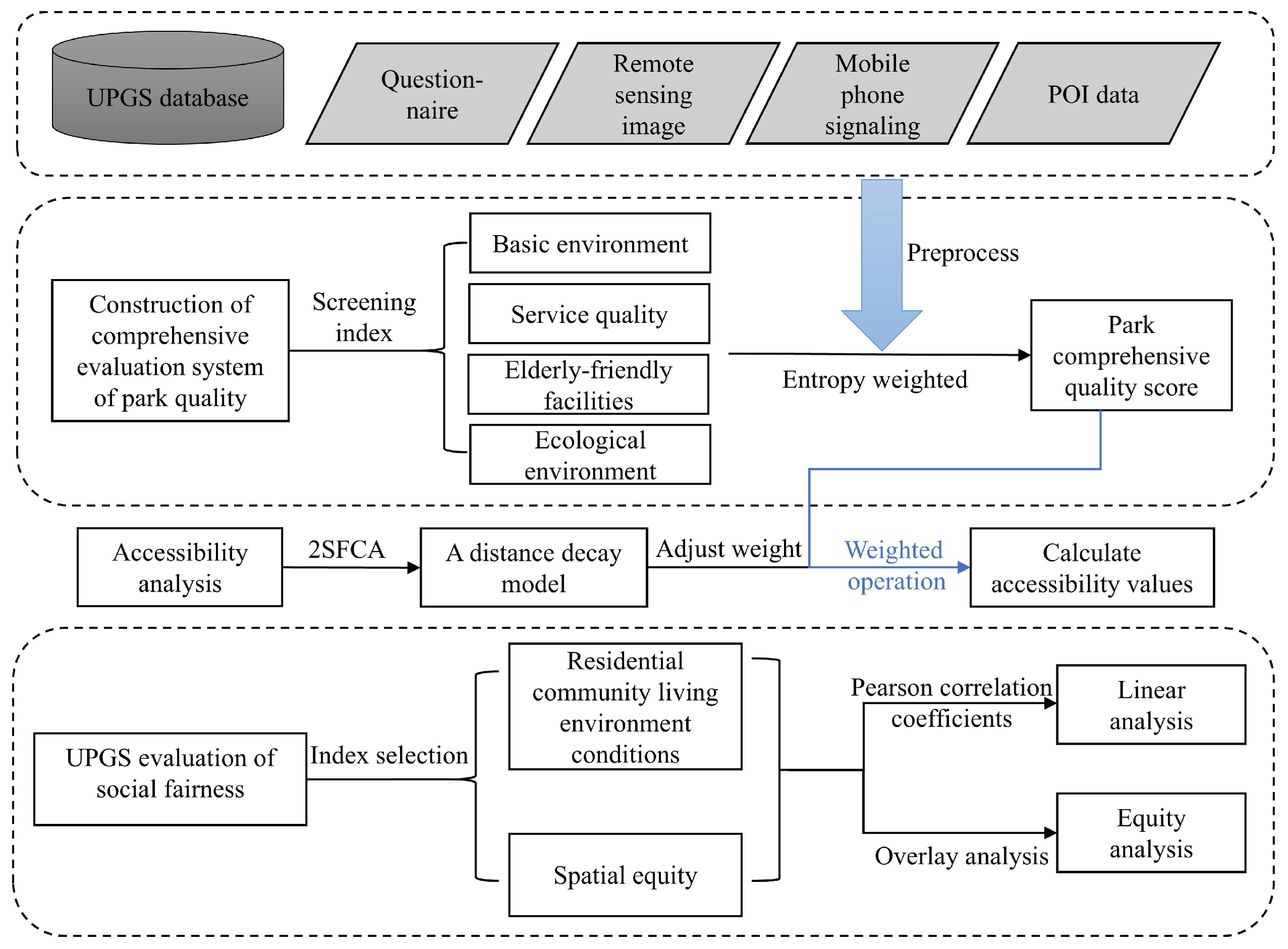
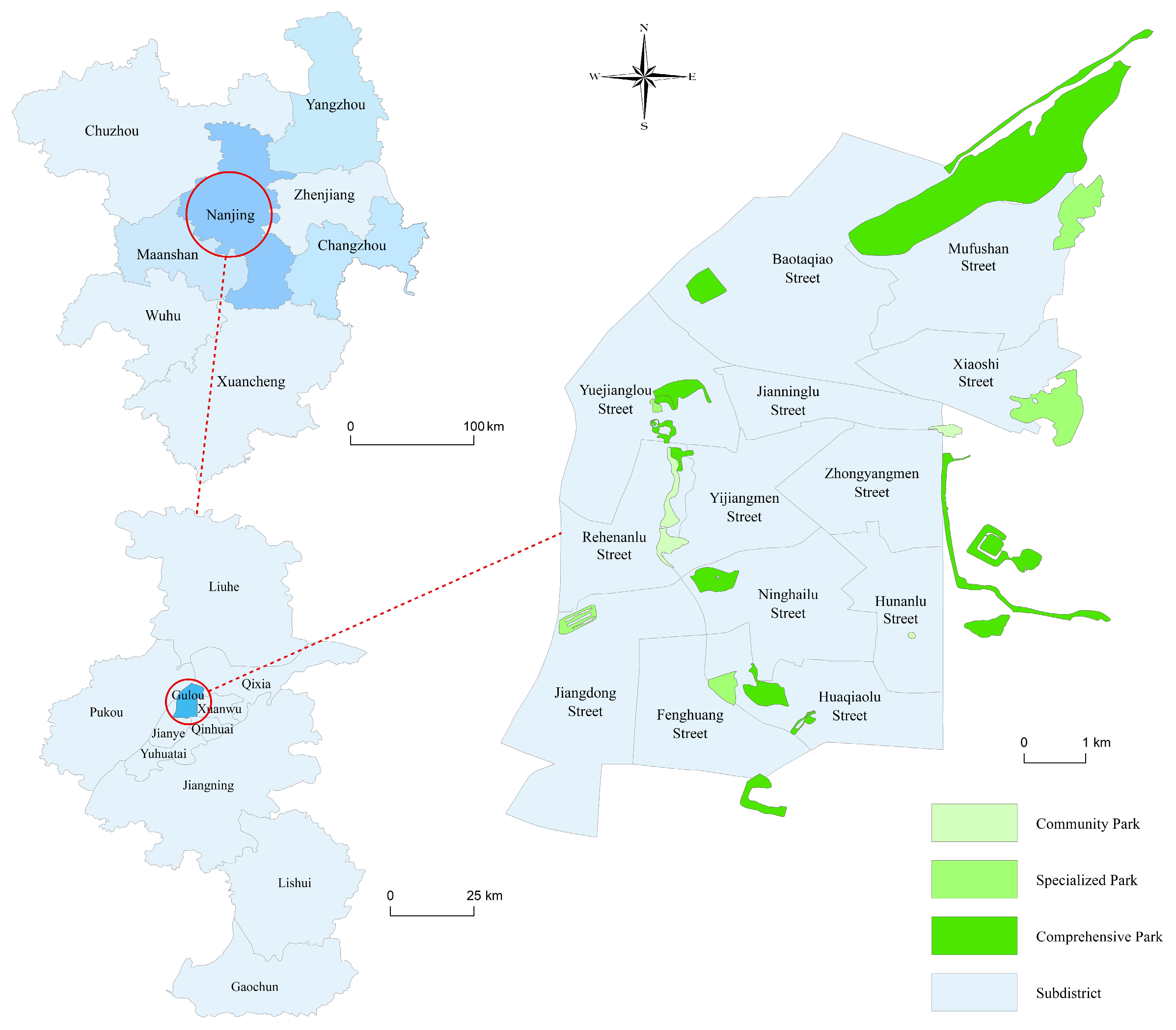
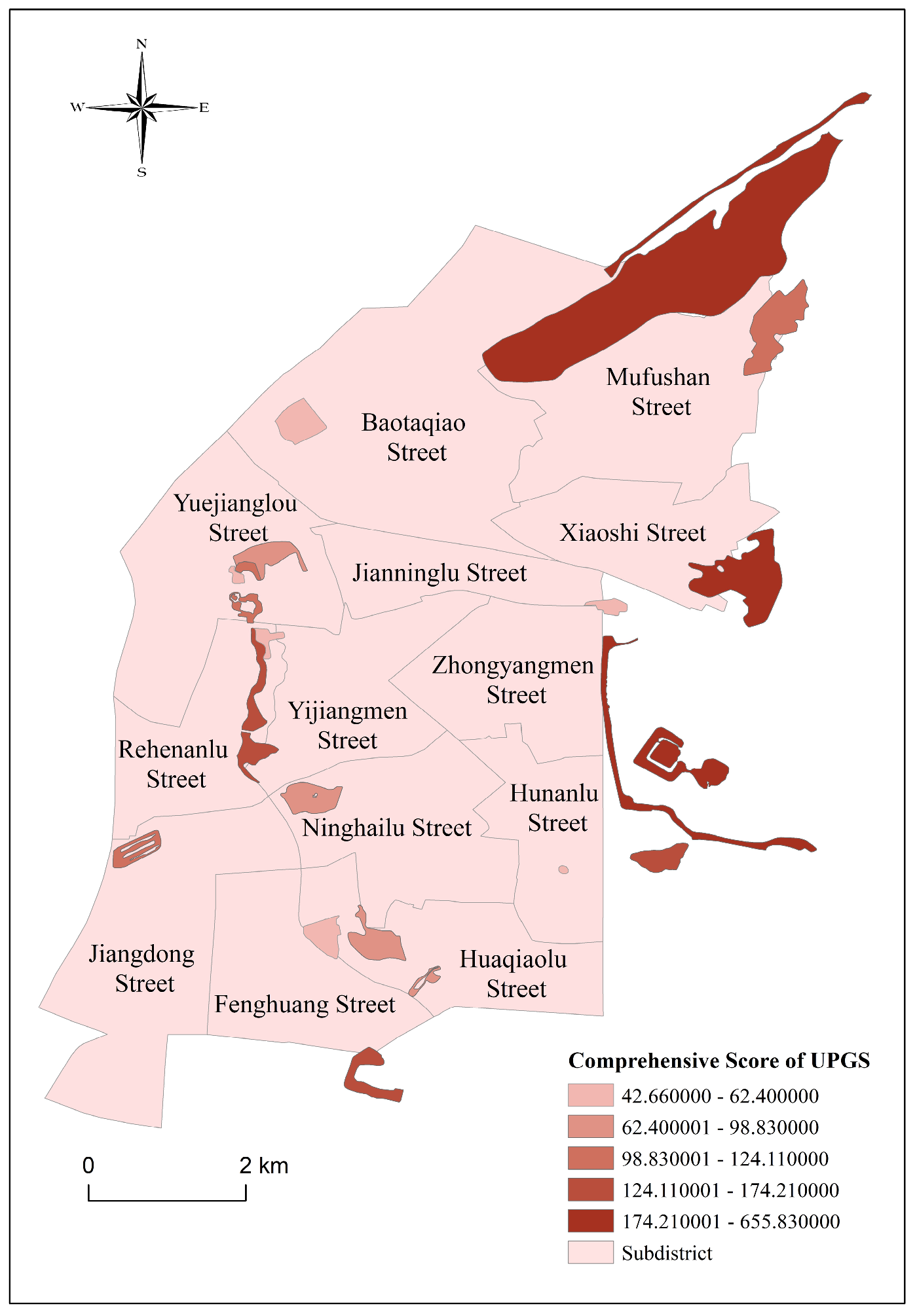


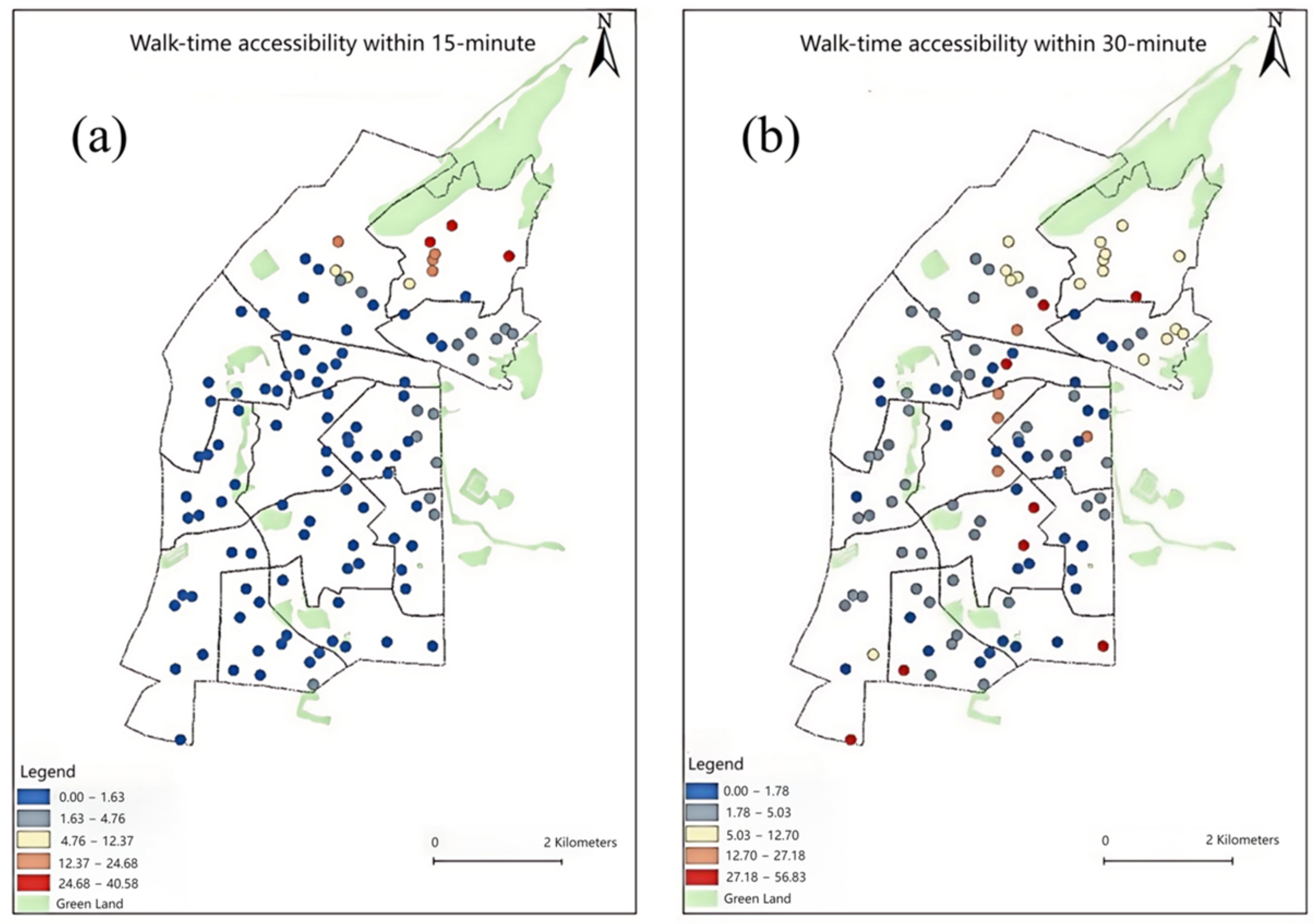
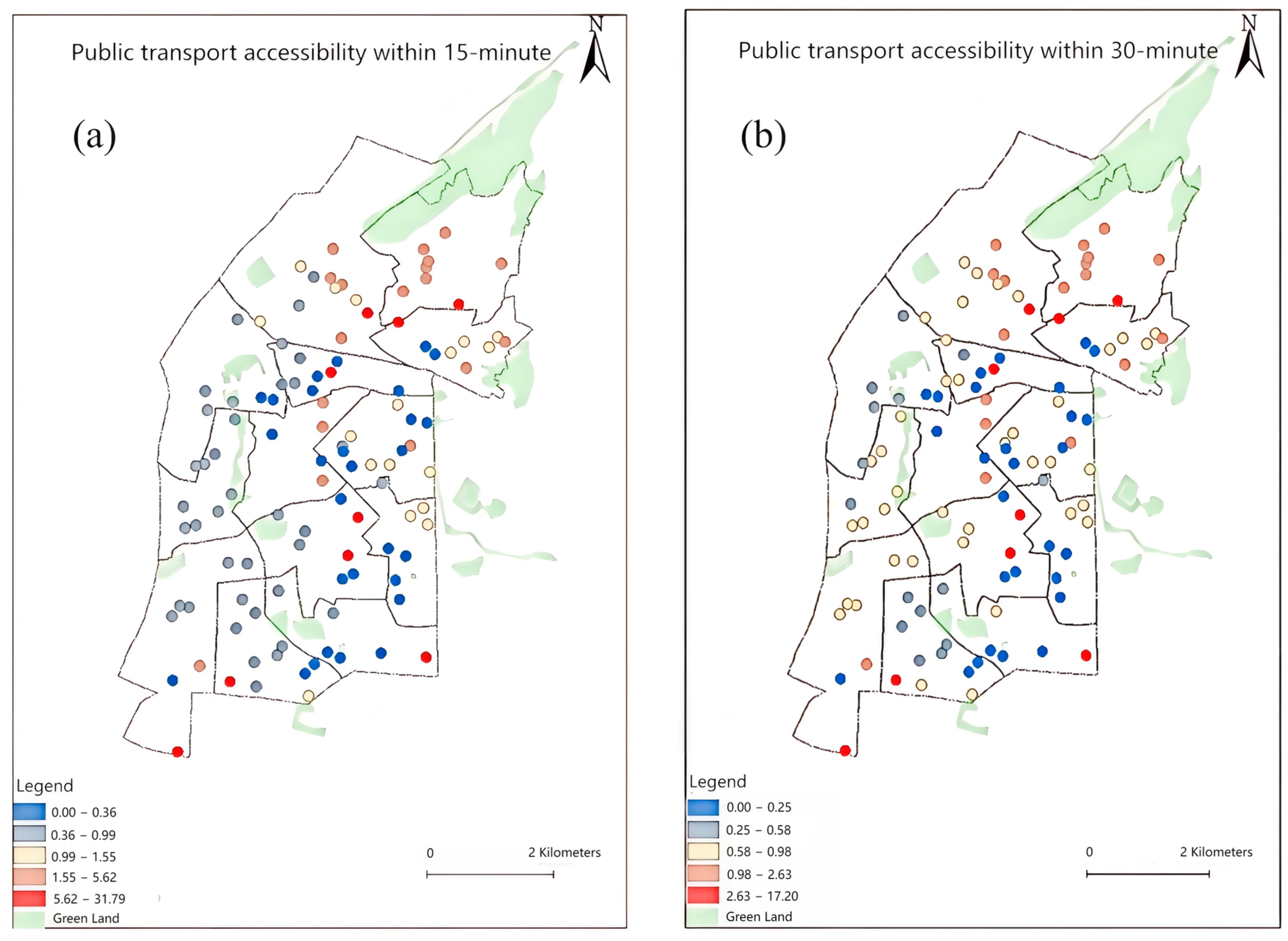

| Data Type | Data Resources | Data Content |
|---|---|---|
| Administrative division data | Map World spatio-temporal information cloud platform | Street administrative boundaries |
| Urban road data | Open Street Map | Urban main roads, secondary roads, and branch roads |
| UPGS data | GF-2 satellite images | UPGS boundary, vegetation and water area, etc. |
| Residential district data | Gaode Map open platform, chain home | POIs, housing prices, etc. |
| Service evaluation data | Questionnaire | Subjective evaluation by older adults |
| Park facility data | On-site investigation, Gaode map | Public service facility POIs, accessibility of facilities, etc. |
| Older adults data | China Unicom Smart Footprint Platform | Number of older adults in each region |
| Primary Indicators | Secondary Indicators | Source | Weight |
|---|---|---|---|
| Basic environment | Area size | Statistically obtained via ArcGIS Arcmap 10.8 vectorization | 0.1552 |
| Shape index | Calculated based on the perimeter and area of each UPGS | 0.1258 | |
| Sanitary conditions | Questionnaires, field research and public comment data, health environment data | 0.0671 | |
| Service quality | Service function diversity | POI data of Gaode map outside the park | 0.0283 |
| Overall satisfaction rate | Number of favorable comments in the questionnaires | 0.1893 | |
| Age-friendly facilities | Internal supporting facilities | POI data derived from Gaode map inside each park | 0.1007 |
| Quantity of age-friendly facilities | Field investigation, number of facilities suitable for older adults | 0.1303 | |
| Ecological environment | Daily average NDVI | Calculated with GF-2 images in 2024 | 0.0997 |
| Daily average NDWI | Calculated with GF-2 images in 2024 | 0.1036 |
Disclaimer/Publisher’s Note: The statements, opinions and data contained in all publications are solely those of the individual author(s) and contributor(s) and not of MDPI and/or the editor(s). MDPI and/or the editor(s) disclaim responsibility for any injury to people or property resulting from any ideas, methods, instructions or products referred to in the content. |
© 2025 by the authors. Licensee MDPI, Basel, Switzerland. This article is an open access article distributed under the terms and conditions of the Creative Commons Attribution (CC BY) license (https://creativecommons.org/licenses/by/4.0/).
Share and Cite
Huang, Y.; Wu, W.; Shen, Z.; Zhu, J.; Chen, H. Beyond Proximity: Assessing Social Equity in Park Accessibility for Older Adults Using an Improved Gaussian 2SFCA Method. Land 2025, 14, 2102. https://doi.org/10.3390/land14112102
Huang Y, Wu W, Shen Z, Zhu J, Chen H. Beyond Proximity: Assessing Social Equity in Park Accessibility for Older Adults Using an Improved Gaussian 2SFCA Method. Land. 2025; 14(11):2102. https://doi.org/10.3390/land14112102
Chicago/Turabian StyleHuang, Yi, Wenjun Wu, Zhenhong Shen, Jie Zhu, and Hui Chen. 2025. "Beyond Proximity: Assessing Social Equity in Park Accessibility for Older Adults Using an Improved Gaussian 2SFCA Method" Land 14, no. 11: 2102. https://doi.org/10.3390/land14112102
APA StyleHuang, Y., Wu, W., Shen, Z., Zhu, J., & Chen, H. (2025). Beyond Proximity: Assessing Social Equity in Park Accessibility for Older Adults Using an Improved Gaussian 2SFCA Method. Land, 14(11), 2102. https://doi.org/10.3390/land14112102






